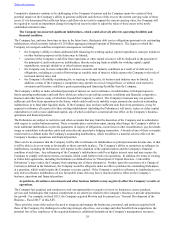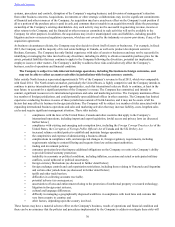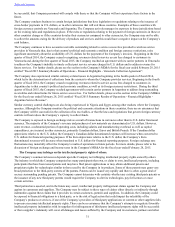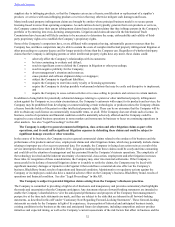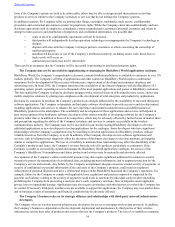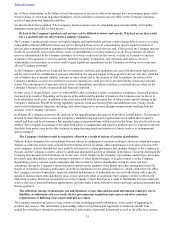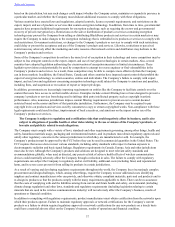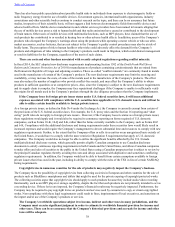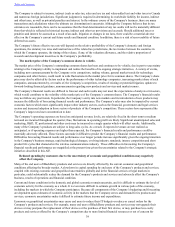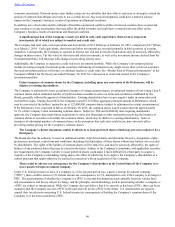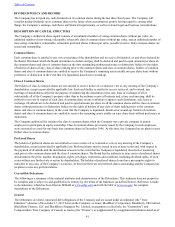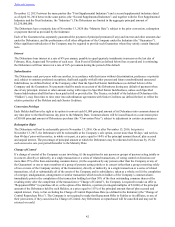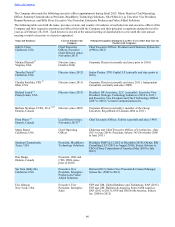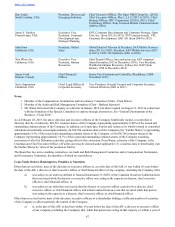Blackberry 2015 Annual Report Download - page 48
Download and view the complete annual report
Please find page 48 of the 2015 Blackberry annual report below. You can navigate through the pages in the report by either clicking on the pages listed below, or by using the keyword search tool below to find specific information within the annual report.
Table of Contents
39
The Company is subject to income, indirect (such as sales tax, sales and use tax and value-added tax) and other taxes in Canada
and numerous foreign jurisdictions. Significant judgment is required in determining its worldwide liability for income, indirect
and other taxes, as well as potential penalties and interest. In the ordinary course of the Company’s business, there are many
transactions and calculations where the ultimate tax determination is uncertain. Although the Company believes that its tax
estimates are reasonable, there can be no assurance that the final determination of any tax audits will not be materially different
from that which is reflected in historical income, indirect and other tax provisions and accruals. Should additional taxes or
penalties and interest be assessed as a result of an audit, litigation or changes in tax laws, there could be a material adverse
effect on the Company’s current and future results and financial condition. In addition, there is a risk of recoverability of future
deferred tax assets.
The Company’s future effective tax rate will depend on the relative profitability of the Company’s domestic and foreign
operations, the statutory tax rates and taxation laws of the related tax jurisdictions, the tax treaties between the countries in
which the Company operates, the timing of the release, if any, of the valuation allowance, and the relative proportion of
research and development incentives to the Company’s profitability.
The market price of the Company’s common shares is volatile.
The market price of the Company’s outstanding common shares has been and continues to be volatile, due in part to uncertainty
relating to the Company's ability to implement and realize the benefits of its ongoing strategic initiatives. A variety of events,
including news announcements by the Company or its competitors, trading volume, general market trends for technology
companies and other factors, could result in wide fluctuations in the market price for its common shares. The Company’s share
price may also be affected by factors such as the performance of other technology companies, increasing market share of such
companies, announcements by, or results of, the Company’s competitors, results of existing or potential litigation, updates to
forward-looking financial guidance, announcements regarding new products and services and market rumors.
The Company’s financial results are difficult to forecast and such results may not meet the expectations of analysts or investors,
which would contribute to the volatility of the market price of the Company’s common shares. The Company’s financial results
may not follow any past trends. In particular, the Company’s entry into new markets and its introduction of new products may
increase the difficulty of forecasting financial results and performance. The Company’s sales may also be impacted by current
economic factors which more significantly impact other industry sectors, such as the financial, government and legal services
sectors and increased adoption in those sectors of products of the Company’s competitors. These sectors have represented the
Company’s largest end user concentration to date.
The Company’s operating expenses are based on anticipated revenue levels, are relatively fixed in the short term to medium
term and are incurred throughout the quarter; thus, fluctuations in operating profit are likely. Significant unanticipated sales and
marketing, R&D, IT, professional and other costs may be incurred in a single quarter which will affect results. Additionally,
many of the Company’s products are subject to long sales cycles. As a result, if expected revenues are not realized as
anticipated, or if operating expenses are higher than expected, the Company’s financial results and performance could be
materially adversely affected. These factors can make it difficult to predict the Company’s financial results and performance.
Difficulties forecasting financial results and performance over longer periods increase significantly given the ongoing transition
in the Company's business strategy, rapid technological changes, evolving industry standards, intense competition and short
product life cycles that characterize the wireless communications industry. These difficulties in forecasting the Company's
financial results and performance are magnified at the present time given the uncertainties related to the Company's strategic
initiatives described in this AIF.
Reduced spending by customers due to the uncertainty of economic and geopolitical conditions may negatively
affect the Company.
Many of the end users of BlackBerry products and services are directly affected by the current economic and geopolitical
conditions affecting the broader market. A slowdown in capital spending by end users of the Company’s products and services,
coupled with existing economic and geopolitical uncertainties globally and in the financial services or legal markets in
particular, could substantially reduce the demand for the Company’s products and services and adversely affect the Company’s
business, results of operations and financial condition.
Current and future conditions in the domestic and global economies remain uncertain, and it is difficult to estimate the level of
economic activity for the economy as a whole. It is even more difficult to estimate growth in various parts of the economy,
including the markets in which the Company participates. Because all components of the Company’s budgeting and forecasting
are dependent upon estimates of economic activity in the markets that the Company serves and demand for its products and
services, economic uncertainties make it difficult to estimate future income and expenditures.
Economic or geopolitical uncertainties may cause end users to reduce their IT budgets or reduce or cancel orders for the
Company’s products and services. For example, many end users of BlackBerry products and services may not upgrade their
devices or may postpone the replacement of their devices or the purchase of their first device, or may purchase less costly
products and services offered by the Company’s competitors due to more limited financial resources or out of concern for


